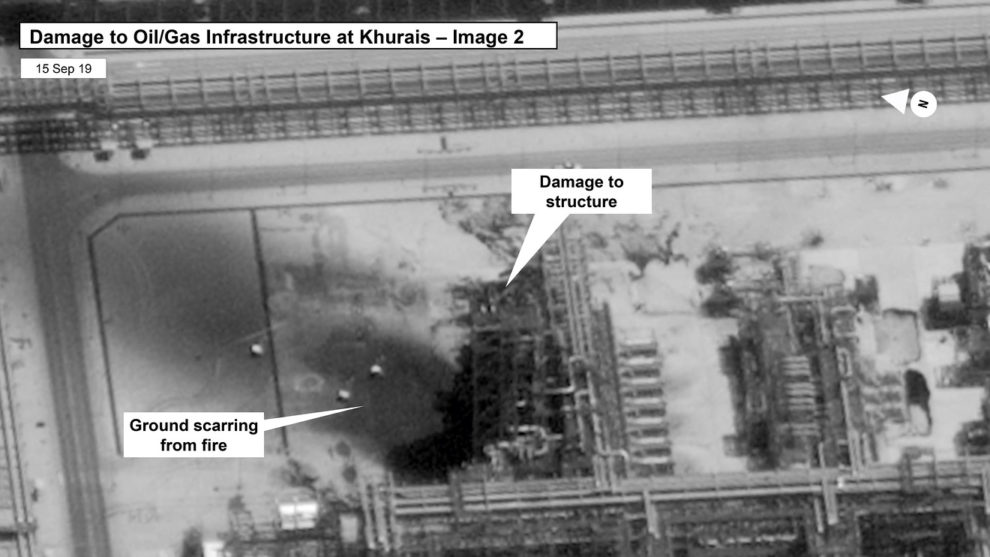
Oil futures on Monday marked the sharpest daily rise in more than a decade after a weekend attack on major crude facilities in Saudi Arabia threatened to create a supply crunch.
West Texas Intermediate crude for October delivery CLV19, +12.89% the U.S. benchmark contract, gained 14.7%, or $8.05, at $62.90 a barrel, representing the largest daily gain for the most-active contract since Sept. 22, 2008, according to Dow Jones Market Data. That put the most-active oil contract at its loftiest level since May 21, 2019.
November Brent crude BRNX19, -1.39% jumped $8.80, or 14.6%, to trade at $69.02 a barrel, its sharpest percentage gain on record and its biggest dollar rise since June 6, 2008.
Price spikes in crude come after a Saturday attack on Saudi Arabia’s Abqaiq plant and its Khurais oil field, which has thrown offline an estimated 5.7 million barrels of the kingdom’s crude oil production a day, equivalent to more than 5% of the world’s daily supply.
The Wall Street Journal, citing Saudi officials, have said a third of output would be restored on Monday, but a return to full production may take weeks, experts have said.
Analysts at S&P Global Platts estimated that Brent oil, the international benchmark, could see a $5 or $10 price surge from its current levels, which could push it to test the $70 range.
“As such prices are likely to break out of the current $55-65/Bbl options range, to test the high $70s as currently supported by fundamentals,” the researchers said.
“In my opinion, it would appear that 3 million barrels will be back online in the next two to five days, but around 2.7 million barrels will take longer due to the unique nature and customized gear at Abqaiq in particular,” wrote Robert Yawger, director of energy at Mizuho Securities, in a Sunday research note.
The Abqaiq facility normally produces 9.8 million barrels of oil a day and is considered one of the world’s largest processors of crude.
“So-called oil ‘supply shocks’ have typically done serious damage to the global economy. That’s partly because of the impact of higher prices, which inflate the cost of fuel and the myriad products derived from oil, particularly chemicals and plastics,” wrote Ken Odeluga, market analyst at City Index.
President Donald Trump said in a series of tweets that he has authorized the release of the Strategic Petroleum Reserve, or SPR, “if needed” to “keep the markets well-supplied.”
The U.S. Department of Energy said the 645 million barrels from the SPR, the largest stockpile of crude in the world, would be made available “to offset any disruptions to oil markets as a result of this act of aggression.”
The SPR was last tapped in 2011.
See: Here are the 3 times the U.S. tapped into its massive emergency oil reserves
The threat of further escalation involving the U.S. also holds the potential to drive crude prices higher still. Trump on Sunday said the U.S. was “locked and loaded,” suggesting that military action may be undertaken. U.S. Secretary of State Mike Pompeo has blamed Iran for the attacks, which Tehran officials have denied.
Tensions are already elevated between Iran and the U.S. after Trump pulled out of a global nuclear pact and imposed fresh sanctions against Iran.
Researchers from the Eurasia Group on Sunday said “the scale of [the weekend] attack will encourage markets to re-examine the need for considering an oil geopolitical risk premium.”
“A small $2-$3 premium would emerge if the damage appears to be an issue that can be resolved quickly, and $10 if the damage to Aramco’s facilities is significant leasing to prolonged supply outages,” Eurasia analysts wrote in a Sunday research report. “At the moment, global balances not as loose as 2018 but not tight either. As a result, the U.S. would only release crude from its Strategic Petroleum Oil Reserves (SPR) if damages to Saudi infrastructure appear critical or oil prices spike significantly,” they said.
“The attack also shows how vulnerable critical global infrastructure can be, as one wouldn’t expect such a scale of damage in Saudi Arabia, especially considering they together account for 50% of the country’s oil output,” wrote Mihir Kapadia, CEO of Sun Global Investments, in a Monday research note.
Rounding out action on Nymex, October gasoline RBV19, +11.35% rose 12.8% to $1.7524 a gallon, marking its biggest percentage gain since Aug. 31, 2017, after logging a 1.3% weekly decline on Friday. October heating oil HOV19, +9.64% advanced 11%, or 20.6 cents, to settle at $2.0838 a gallon, after producing a weekly loss of 1.2%.
Natural-gas futures, meanwhile, saw the October contract NGV19, +2.45% climb 6.7 cents, or 2.6%, to end at $2.6810 per million British thermal units, adding to its 4.7% climb from last week.











Add Comment